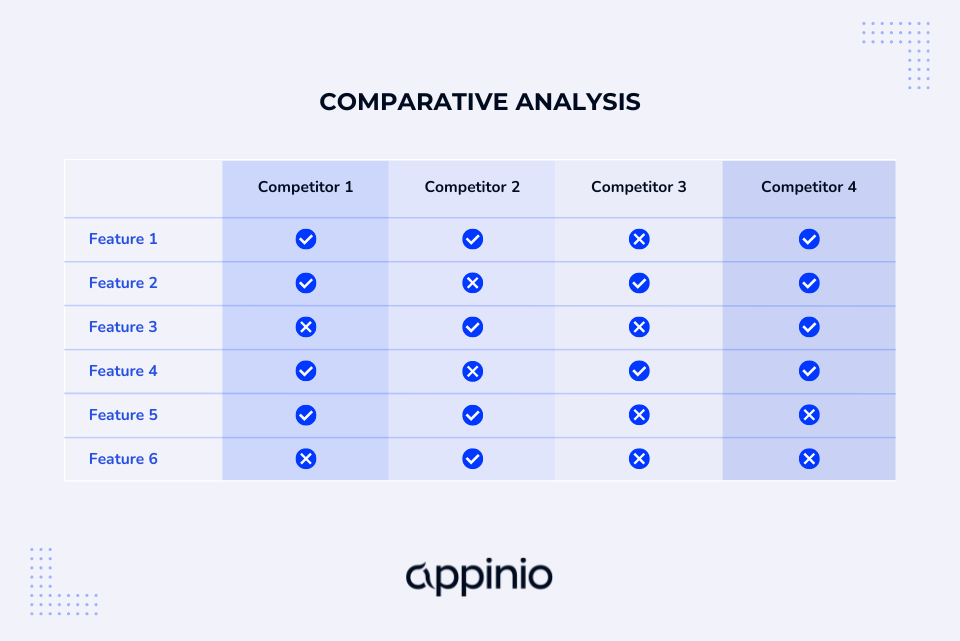Competitive Analysis
Appinio Research · 20.10.2022 · 12min read

Content
In the world of business, competition is just as fierce as in a cycling race. To stay ahead of the game, companies must constantly innovate, offer better products and services, and effectively meet customer needs. To achieve this, a keen sense of awareness is necessary. Just like in a race, businesses must keep a watchful eye on their competitors and analyze their every move.
That's where competitive analysis comes in. Its primary purpose is to help companies stay ahead of the competition by providing insights into their rivals' strengths and weaknesses.
In this article, our market research experts explain:
- Everything you need to know about competitive analysis
- The insights competitive analysis provides, and
- Why digital market research is an ideal tool for systematically examining your competitors
What is a Competitive Analysis?
 A competitive analysis is a vital part of market analysis from the customer's perspective.
A competitive analysis is a vital part of market analysis from the customer's perspective.
It involves systematically exploring the current and potential competition to reveal both the strengths and weaknesses of your own company and your competitors.
A comprehensive competitive analysis achieves the following:
- Systematically explores current and potential competition
- Reveals strengths and weaknesses of your own company and competitors
- Identifies future trends and potential threats to your business
- Provides insights into the strategies of your competitors
By identifying your main competitors, understanding their strategies, and using this knowledge to overtake them, you can position your company more strategically in the market.
Recognizing your weaknesses in comparison to your competitors helps you identify areas that need improvement, while emphasizing your strengths enables you to build on them and create a unique value proposition.
A competitive analysis is particularly useful in the following scenarios:
- Introduction of new products
Are these products already available in the market? How well are they received by consumers? - Start-up of a new company
What is the structure of the target market? - Development of new target groups
Which target groups do I serve, and which ones are being served by the competition? - Development of innovations
What unique and innovative products can my company offer in the market? - Review of marketing strategies
How do competitors advertise, and how is it perceived by the target audience? - Examination of recruiting strategies and employer image
How do competitors hire new employees, and how satisfied are the employees at competing companies?
Gaining knowledge about competitors is challenging. Without understanding their strategies, it is almost impossible to outperform them.
It is important to gather insights from consumers, who are the primary source for competitive analysis. Their opinions on your products and those of the competition can make all the difference.
Consumer opinions play a vital role in purchase decisions, ultimately deciding whether a product or service is successful.
A critical aspect of competitive analysis is reaching out to consumers directly through surveys, not just your own customers but also potential customers that fit your target group.
Digital market research is an ideal tool for competitive analysis from a consumer's perspective. It enables the collection of thousands of opinions in a short amount of time, providing valuable insights that can help a company gain an edge over its competitors.
💡 Want to learn more about competitive analysis? Talk to our experts.
How to conduct a Competitive Analysis step by step
 To start a competitive analysis, a clear objective should be established to guide the study. This goal determines the approach to be taken and the questions to be asked.
To start a competitive analysis, a clear objective should be established to guide the study. This goal determines the approach to be taken and the questions to be asked.
For example, a company may want to know who its primary competitors are, why consumers switch brands, or how its marketing strategy compares to that of other companies.
Once the objective is established, questions are formulated to obtain the necessary information.
To illustrate how digital market research can be used for competitive analysis, let's consider a fictitious supermarket, Supermarket A.
To sell its products successfully, Supermarket A needs to outperform its competitors by offering a more varied assortment, lower prices, well-stocked fresh food counters, multiple locations, and a unique selling proposition that sets it apart.
To understand what customers want and what motivates them to shop at a specific store, Supermarket A must survey its customers.
Questions to consider include:
- What can Supermarket A offer to build customer loyalty?
- What do other supermarkets offer that Supermarket A doesn't
- How likely are its customers to shop at those stores?
Our useful questionnaire guide will help you create a bulletproof questionnaire.
Step 1: Identify your main competitors
Identifying all relevant competitors is a crucial first step in conducting a competitive analysis.
Key competitors are those companies that offer similar products or services to the same target audience as your company. These can include current suppliers in related markets as well as potential future entrants.
For example, if a fictitious supermarket, Supermarket A, wants to assess how it is perceived compared to other supermarkets, it needs to identify which other supermarkets to include in the analysis.
A competitive analysis questionnaire should therefore ask consumers to name potential competitors and indicate where they buy, which companies they know, and whose products they do not purchase.
Consumers should also be asked to name a few brands spontaneously to determine how present a particular company or brand is in their minds.
Below are some question ideas to identify competitors:
- Thinking of supermarkets, which names come to your mind spontaneously?
- In which supermarket do you regularly buy groceries?
- Supermarket A
- Supermarket B
- Supermarket C
Step 2: Obtain information about your competitors
To develop a competitive analysis, it's crucial to define precisely what information is needed to understand the competition.
Consumer surveys can provide valuable insights that may not be readily apparent and only come to light through strategic questioning.
For instance, understanding why consumers prefer a particular brand or supplier could be illuminating. Age demographics can be used to determine which segment your brand is popular with, and asking how consumers perceive different competitors' advertisements compared to your own can reveal valuable information.
In the case of the fictitious supermarket, it would be beneficial to know why consumers choose one supermarket over another. An open-ended question or a question with multiple answers can be used to gather this information.
Asking open-ended questions has the advantage of revealing information that would otherwise not have been available.
- Why are you shopping in this particular supermarket/supermarkets?
- Lowest prices
- Best quality
- Largest selection
- Is closest
- Another reason, namely: (free text)
As part of a competitive analysis, the supermarket could also test which advertising strategy consumers are more reactive to.
Assuming that supermarket A has a Facebook page where it shares recipe tips, informs customers of current offers, and offers online customer support, while supermarket B conducts marketing on YouTube.
To determine which platform is preferred by customers, supermarket A can ask them for their opinion.
-
Do you think it is appealing when a supermarket has a social media presence?
-
- Yes
- More likely yes
- Rather no
- No
Step 3: Find strengths and weaknesses of your own company and those of your competitors
In conducting a competitive analysis, it's important to identify the strengths and weaknesses of your competitors, as well as your own company's position.
To accomplish this, you must determine what factors are critical in your industry.
For instance, if supermarket A determines that customer service, checkout speed, product quality, and organic options are vital, it can investigate how these attributes are perceived by customers when comparing its competitors.
- In which supermarket do you find the most friendly staff?
- Supermarket A
- Supermarket B
- Supermarket C
- Other, which is [free text]
In addition to identifying the strengths of competitors, it's crucial to evaluate your own company's weaknesses and determine areas that require improvement to catch up with the competition.
For instance, supermarket A could ask participants to identify where they believe the longest waiting times at checkout occur, in comparison to other supermarkets.
Another important aspect is to determine if your company has a unique selling point that sets it apart from the competition. This can be accomplished through an open-ended question, such as:
- In what ways do you think supermarket A is superior to other supermarkets?
The aim is to gather keywords that are frequently mentioned to highlight what customers value most about the company. By emphasizing this advantage even further, the company can gain a competitive edge.
Here are a few more examples of questions that could be included in a competitive analysis:
- Please tell us a reason why you would change your telecommunications provider.
- Here are five sneaker brands. In your opinion, which do you think offers the best design in general?
- Which drugstore is closest to your home?
- When you think of coffee shops, which chain comes to your mind spontaneously?
- What does a sportswear brand need to offer you to buy there again?
- Which detergent advertising campaign has been on your mind lately?
- Which of these insurance providers would you trust the most?
- Please think of a modern café. What would it have to offer to be ahead of others?
Analysis of the results
Digital market research offers the advantage of quickly obtaining a plethora of ideas, opinions, and evaluations from consumers of various target groups.
These data form a crucial basis for future corporate strategies and marketing. The large amount of data collected at the beginning of a survey, such as demographic information, can provide unexpected insights.
For instance, in the case of supermarket A, they could retrospectively analyze which supermarket names come to the minds of consumers in different cities or which stores attract certain age groups.
If they find that their store is unpopular among young people in a particular area compared to the competition, they could target this group in their future marketing strategies.
Interested in running your own Competitive Analysis?
Find questionnaire templates and sample surveys to get your competitive analysis started in minutes via the Appinio dashboard
Get facts and figures 🧠
Want to see more data insights? Our free reports are just the right thing for you!


